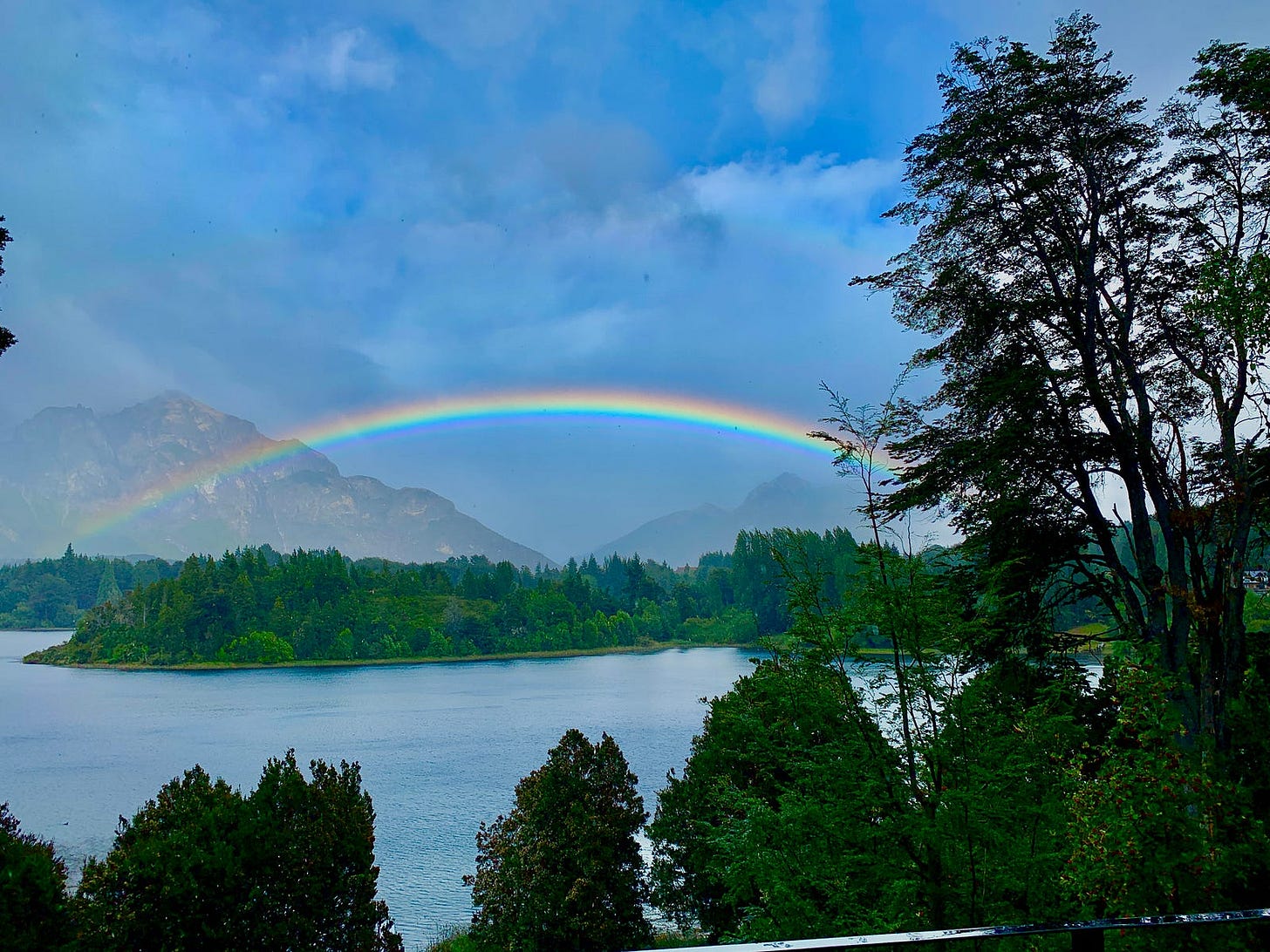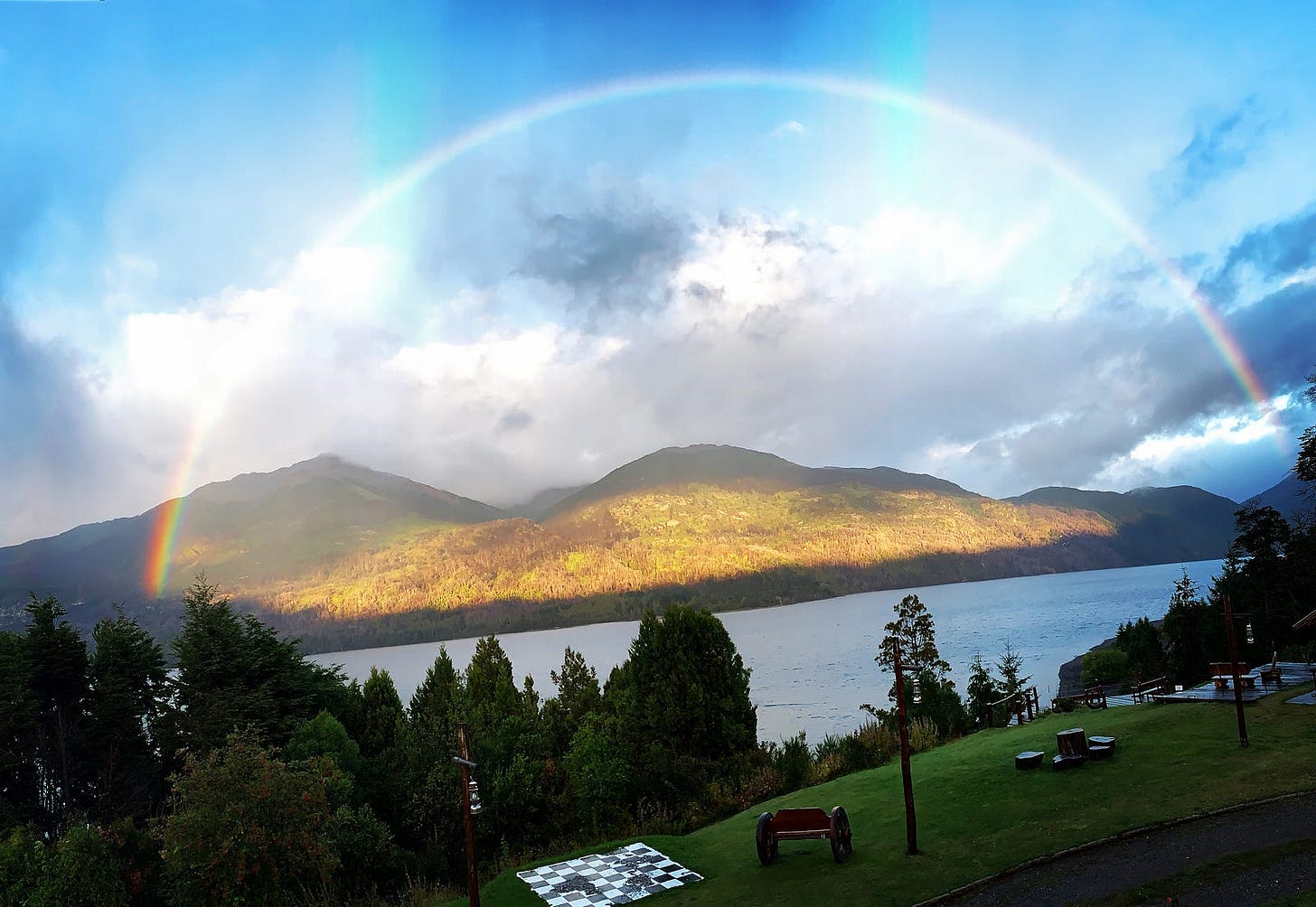The Sound That Became the Guru
How a chant, a rainbow, and two voices opened the door to the sacred
✧ The Mantra Path
In every sacred tradition, sound comes before structure. The mantra begins not as music, but as medicine — a living frequency designed to awaken, purify, and align. Om Ah Hum is the foundational triad: Om unifies body with the cosmos, Ah expresses the truth of speech, and Hum crystallizes clarity of mind. Together, they are not chanted — they are entered. Mantras are not performances. They are invitations. And with the right intention, they become portals into the very field of the divine.
✧ The Icaro Path
In the Amazon, the Icaro is more than a song — it is a living intelligence, sung not from memory, but from the heart of the forest itself. Received in visions, born of deep plant communion, Icaros are vibrational maps that guide healing, harmonize energy, and invoke spirit. They often begin with simple, elongated sounds that mimic the jungle’s breath — wind, water, bird, leaf. To sing an Icaro is to walk sound into form, to breathe harmony into chaos, to heal through resonance, not reason.
✧ Ide Were Were: The First Incantation
Before the mantras, before the mountains, before the names of the Buddhas and the maps of inner worlds, there was a song.
“Ide Were Were.”
A chant. A rhythm. A calling.
When Renato and Nanala first sang it — under the name of their musical offering, Emanazul — they didn’t yet know they were stepping into a spiritual path. They only knew it moved something.
Ide Were Were carries deep spiritual resonance in Afro-Brazilian and Yoruba traditions, often associated with Oshun, the Orisha of fresh waters and divine feminine energy. Though the syllables seem wordless, they are not meaningless — they are sonic codes, vibrating with ancient memory, alive with invocation.
It was the sound of beginning. A song sung not as performance, but as prayer. And it marked the first note in what would become a pilgrimage through worlds.
✧ From Ayni to the Rainbow Body
I’ve known Renato for almost two decades, and Ana Clara — who I call Nanala — for sixteen years. I’ve witnessed their transformation: from gifted musicians exploring sound as ceremony to devotees of vibration, whose music became a living offering.
Their path led first through the Andean Cosmovision — a living spiritual worldview where every mountain is a relative, every river a mirror. They studied the ways of the Q’ero elders, receiving Karpays — energetic transmissions passed down in sacred ceremonies, often atop high-altitude mountains like Ausangate, the apu of the Southern Andes. Karpay, in Quechua, means “to seed.” These were not teachings in the Western sense. They were initiations — invisible blessings woven into breath.
Central to the Andean path is Ayni — a principle often translated as reciprocity, but more truthfully, it is a relational ethic of life itself. Ayni is not about balance sheets or barter. It is about belonging. When you give, you are completing the circle of existence.
It was through these teachings that Renato and Nanala’s music deepened. They began to receive songs, rather than compose them. At first, their sound echoed the Icaros of the Amazon — vibrational healing chants used in sacred ceremonies, sung by curanderos to guide, protect, and illuminate.
But something more subtle was calling.
✧ The Mantra that Opened the Door
At some point, Padmasambhava arrived.
Known as the Second Buddha, Padmasambhava— or Guru Rinpoche — was the 8th-century tantric master who brought Vajrayana Buddhism to Tibet. He is said to have subdued spirits, translated texts, and left termas — hidden teachings encoded in rocks, rivers, and minds — for future generations.
His mantra — Om Ah Hum Vajra Guru Padma Siddhi Hum — is not merely a chant. It is a living portal. The syllables purify body, speech, and mind. They invoke the indestructible teacher, the lotus-born master, and his awakened realization. The mantra is both invitation and transmission.
Years ago, I began chanting it myself, without knowing what I was truly saying. I used it as a meditation tool — a way to quiet the mind. It helped, but I couldn’t feel its depth. It wasn’t until Renato and Nanala came to visit us in Patagonia that the mantra revealed its presence.
✧ Patagonia: Where the Sky Opened
One evening, we sat around the fire under a cold southern autumn sky. The air was crisp, the silence vast. That night, something began to emerge. Renato cradled his guitar, and Ana — Nanala — held a small hand drum. We were encircled not only by friends, but by the Apus — the sacred mountains that, in the Andean Cosmovision, are considered living spirits, ancient protectors and wise elders of the land. In this worldview, an Apu is not a metaphor — it is a conscious presence, a mountain-being with which one is in relationship, through offering, reverence, and song.
Around the fire, with the Apus watching and the stars listening, they began to chant. They offered their voices to Padmasambhava — not with performance, but with prayer. And their voices trembled in reverence, as if tuning into something far older than language.
The mantra — Om Ah Hum Vajra Guru Padma Siddhi Hum — was not recited. It arose. It emerged, not from memory, but from the moment itself. There was no geography, no time zone, no cultural reference. The sound belonged neither to Tibet, nor to the Andes, nor to us. It was timeless and spaceless. An energy breaking through the veil, carried on vibration. A transmission unfolding not just in melody, but in presence.
✧ Rainbows and the Body of Light
The next morning, a rainbow appeared. (showcased at the opening of this article) It stretched across the sky without warning — silent, radiant, complete. No one said a word. We just looked. Later we would understand: it wasn’t just a rainbow. It was the first sign that something had opened. A doorway. A presence. A reply. The mantra had begun to sing through us — and the sky, it seemed, was listening
Later, as we traveled south toward Pata in Futaleufú to visit our friend Marcelo, the pattern repeated. Each time Renato and Nanala paused to sing the mantra — just the two of them, in stillness — another rainbow appeared. Three times. Three rainbows. Three confirmations.
At Lake Futalaufquen, I captured a photo of Renato standing quietly at the water’s edge, the rainbow arching behind him like a crown.
In Tibetan Buddhism, Padmasambhava is intimately associated with rainbows, not as a symbol but as a manifestation. It is said that great masters, at the moment of death, can dissolve their physical form into pure light — a phenomenon known as the Rainbow Body. Padmasambhava not only attained this state but taught the path to it. The rainbow is not coincidence. It is a spiritual signature, a message: the Guru is near.
What began as a whispered offering around a Patagonian fire has now become a complete musical prayer. The mantra that first emerged that autumn night — fragile, trembling, and alive — has since evolved into a full song, now shared with the world. You can listen to it on Spotify [link below]. It carries with it the memory of the Apus, the crackling fire, the southern wind, and the rainbow that crowned its birth. What was once a moment has become a living transmission.
Om a Hung Mantra by Emanazul on Spotify
✧ The White Tara Transmission
In time, another energy began to flow through their music: White Tara, the Bodhisattva of Compassion, Healing, and Long Life.
Her mantra, Om Tare Tuttare Ture Mama Ayur Punya Jñana Pushtim Kuru Svaha, came like a whisper. One night, around the fire, Nanala began to chant it — softly, reverently. The air shifted. Her voice became moonlight. White Tara did not arrive with force. She arrived as grace — not to dazzle, but to hold.
Her presence softened everything. And their music entered a new phase. It was no longer about singing to the sacred. It was resting in it.
✧ Final Offering
What began as exploration has become embodiment.
Their music is no longer about style or influence. It is not a fusion of Amazonian, Andean, and Tibetan. It is a field, a vibration, a subtle language between soul and cosmos. It has never been about finding something new. It has been about remembering what is already singing through us.
I speak from ignorance, not attainment. I have only glimpsed the edge of a path that is ancient, layered, and immeasurably deep. The world of mantras is not a songbook. It is a cosmology, a science of sound that awakens the architecture of consciousness itself. There are countless inner practices that precede the moment when a mantra truly makes sense — not intellectually, but energetically.
But sometimes, even without mastery, something moves.
As the key unlocks the door, and the hand turns the knob, what matters most is the intention behind the gesture. A sincere heart can awaken the sacred just as surely as a trained one.
To chant with humility is to step into recognition.
To sing with reverence is to step into realization.
To offer sound as devotion is to participate in a quiet revolution.
And sometimes, that’s all it takes for the mantra to do its work —
Not because we have mastered it,
But because, for one sacred moment,
We let it master us.









Ahh! You have dropped another Pearl! Thank you!
Ernesto, greetings. I think of you often. Some of us obviously surf the same wave on a vast ocean.
I realized quite recently that nothing I've studied or done in the last quarter of a century is of any use to me now. Nor what I know from the quarter of a century before that from an experience of a totalitarian regime. My clients who should be in charge of changing institutions are too scared to know anything about anything concerning the future. I thought I was prepared to be their guide when the time is coming. But that's not the case. All I can do is to be the void of possibilities in which they could feel the the glimps of resonance. When I red your recent substack article I remembered a Otto Scharmer´s story about a violoncellist who played a concert in the cathedral of Chartres. Halfway through the concert he realized the cathedral. And he heard her yelling at him ‘Get out of here, you have no business here if you can't play with me, you're only playing for yourself’. Maybe the whole journey, the same shelves of books we all have (Berry, Abram, Swimme, Assagioli, native cultures and nature and the list goes on and on) weren't ever ment for us to be storytellers of that story, but instead of it to become it as soon as we can... My heart sits around the fire in Patagonia. Alexandra